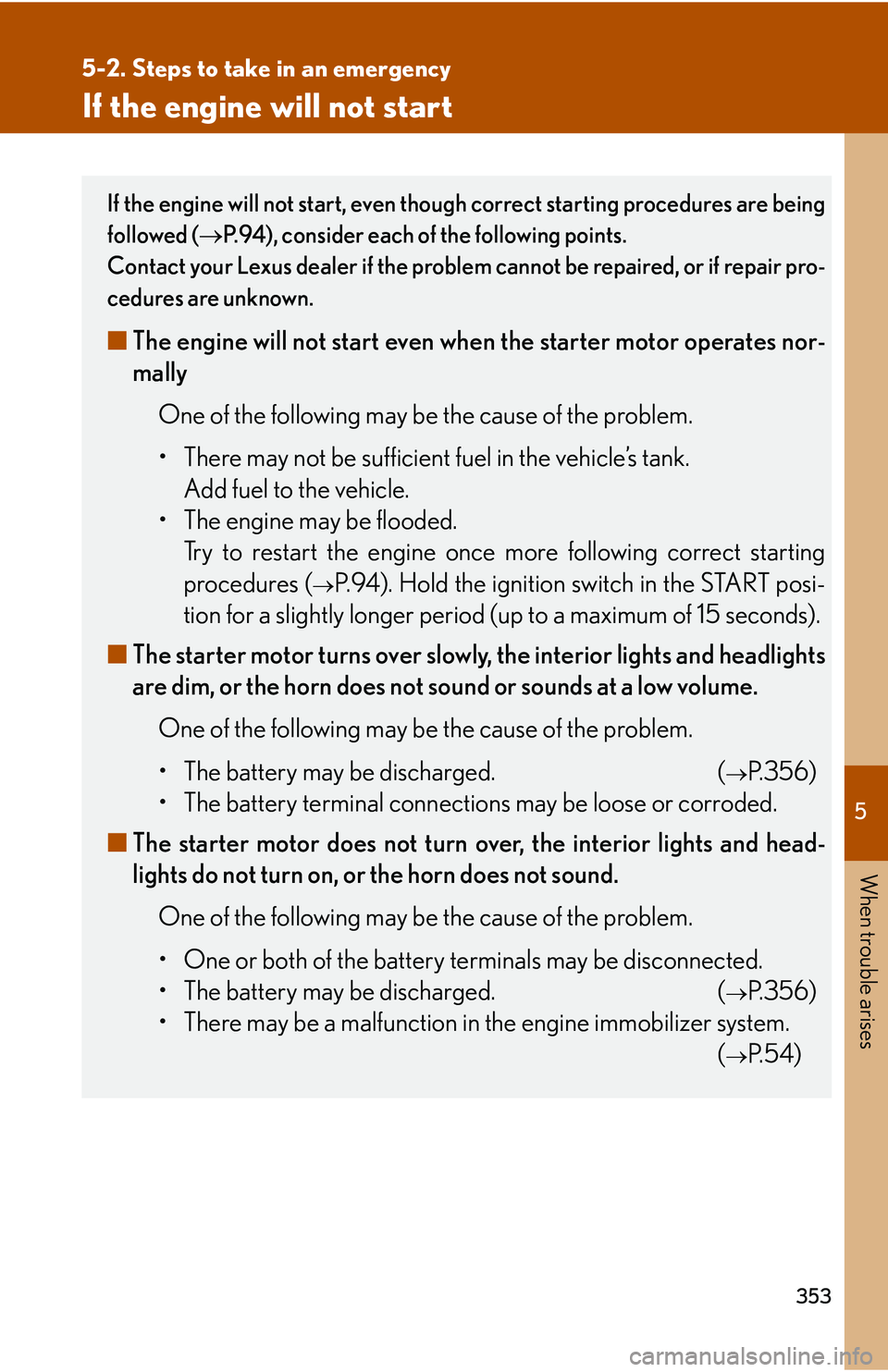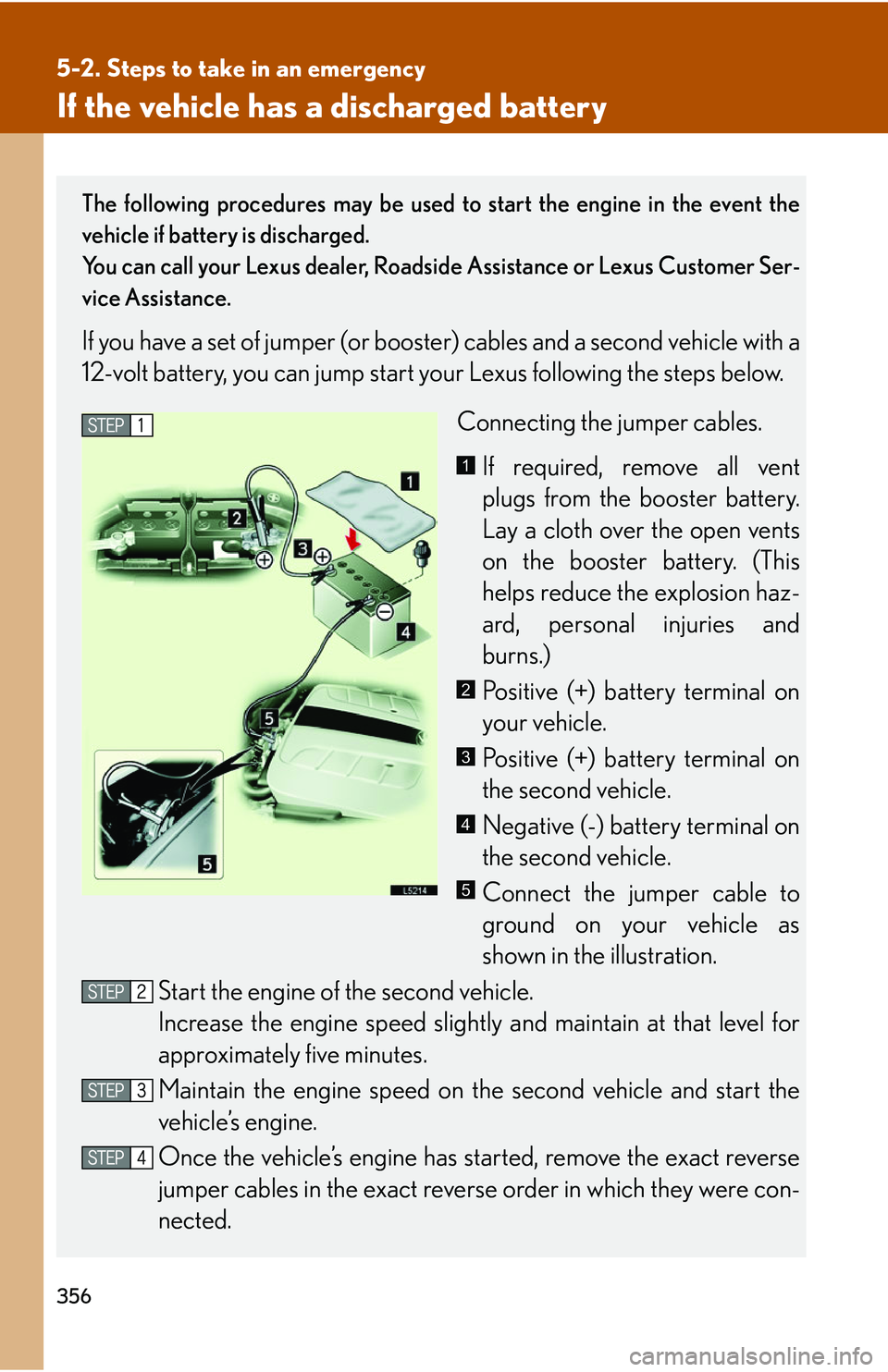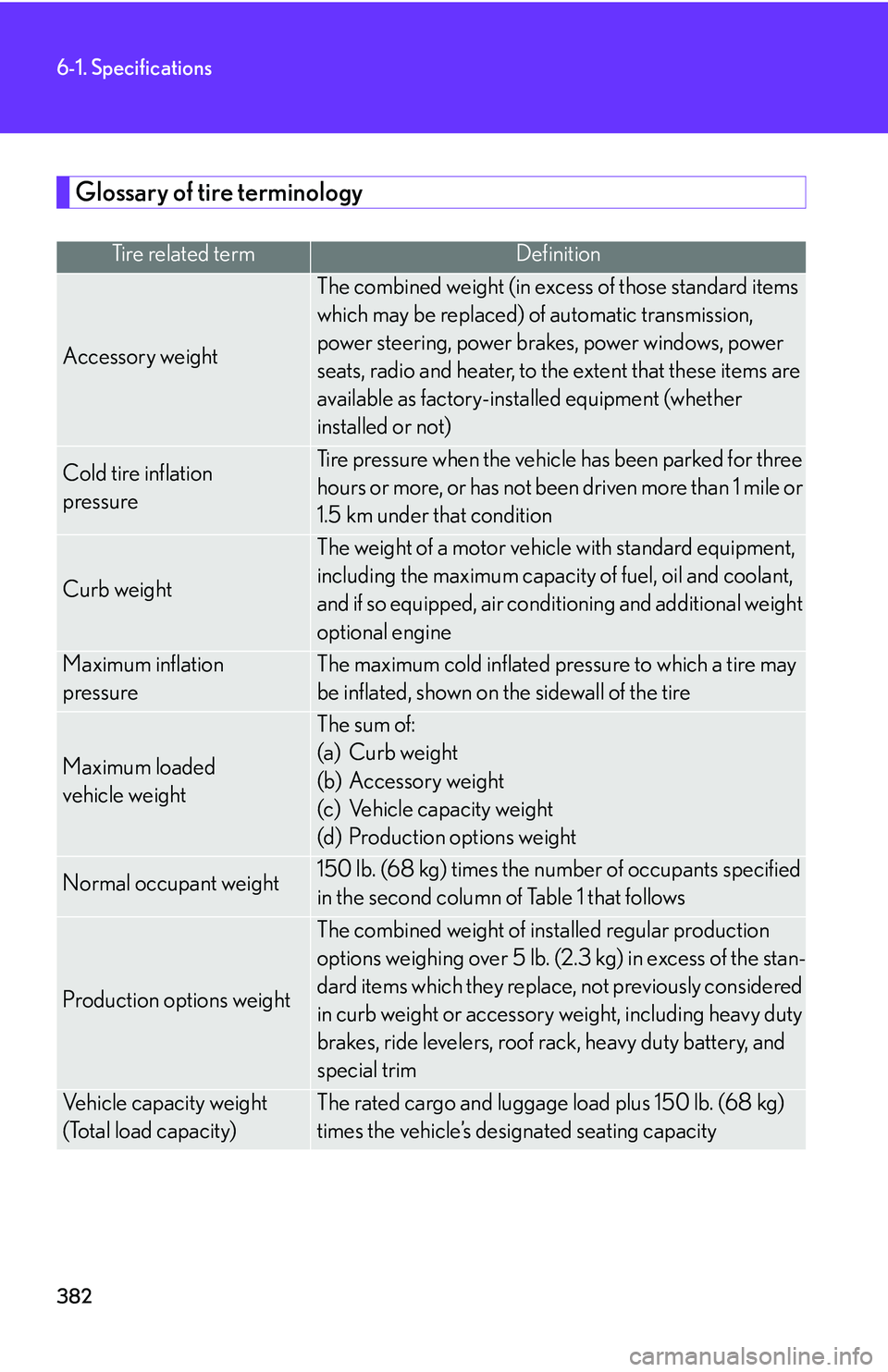Page 335 of 419
5When trouble arises
319
5-1. Essential information............ 320If your vehicle needs to be
towed .......................................... 320
If you think something is
wrong.......................................... 324
Fuel pump shut off system ..... 325
Event data recorder................. 326 5-2. Steps to take in an
emergency ........................... 328
If a warning light turns on... ... 328
If a warning message
appears... ................................... 334
If you have a flat tire .................. 347
If the engine will not star
t....... 353
If the transmission selector
lever cannot be shifted
from P ......................................... 354
If you lose your keys................. 355
If the vehicle has a
discharged battery................ 356
If your vehicle overheats........ 359
If the vehicle becomes
stuck .............................................. 361
Page 362 of 419
346
5-2. Steps to take in an emergency
One
buzzerNone(shown for about 5 sec-
onds)
Key battery
charge is insuf-
ficient.
Replace key
battery
(P.295
).
One
buzzerNone(shown for about 5 sec -
onds)
An attempt is
made to use a
key that does
not match the
vehicle.
Use a key that
matches the
vehicle.
Inside
alarmOutside alarmMulti-information displayCausesCorrection
procedures
Page 369 of 419

5
When trouble arises
353
5-2. Steps to take in an emergency
If the engine will not start
If the engine will not start, even though correct starting procedures are being
followed (P.94), consider each of the following points.
Contact your Lexus dealer if the problem cannot be repaired, or if repair pro -
cedures are unknown.
■ The engine will not start even wh en the starter motor operates nor-
mally
One of the following may be the cause of the problem.
• There may not be sufficient fuel in the vehicle’s tank.
Add fuel to the vehicle.
• The engine may be flooded.
Try to restart the engine once mor
e following correct starting
procedures (
P. 94 ). Hold the ignition switch in the START posi -
tion for a slightly longer period (u p to a maximum of 15 seconds).
■ The star
ter motor turns over slowly , the interior lights and headlights
are dim, or the horn does not sound or sounds at a low volume.
One of the following may be the cause of the problem.
• The battery may be discharged. (
P.356 )
• The battery terminal connectio ns may be loose or corr
oded.
■ The star
ter motor does not turn over, the interior lights and head-
lights do not turn on, or the horn does not sound.
One of the following may be the cause of the problem.
• One or both of the battery terminals may be disconnected.
• The battery may be discharged. (
P.356 )
• There may be a malfunction in the engine immobilizer system. (
P.54)
Page 372 of 419

356
5-2. Steps to take in an emergency
If the vehicle has a discharged battery
The following procedures may be used to start the engine in the event the
vehicle if battery is discharged.
You can call your Lexus dealer, Roadside Assistance or Lexus Customer Ser -
vice Assistance.
If you have a set of jumper (or boos ter) cables and a second vehicle with a
12-volt battery, you can jump start y our Lexus following the steps below.
Connecting the jumper cables.If required, remove all vent
plugs from the booster battery.
Lay a cloth o
ver the open vents
on the booster battery. (This
helps reduce the explosion haz -
ard, personal injuries and
bur
ns.)
Positive (+) battery terminal on
your vehicle.
Positive (+) battery terminal on
the second vehicle.
Negative (-) battery terminal on
the second vehicle.
Connect the jumper cable to
ground on your vehicle as
sho
wn in the illustration.
Start the engine of the second vehicle.
Increase the engine speed slightly and maintain at that le
vel for
approximately five minutes.
Maintain the engine speed on the second vehicle and start the
vehicle’s engine.
Once the vehicle’s engine has st ar
ted, remove the exact reverse
jumper cables in the exact reverse or
der in which they were con-
nected.
1
2
3
4
5
Page 373 of 419

5
When trouble arises
357
5-2. Steps to take in an emergency
■Avoiding a discharged battery
●Turn off the headlights and the audio system while the engine is turned off.
●Turn off any unnecessary electrical comp onents when the vehicle runs at a low
speed for an extended period, such as in heavy traffic, etc.
CAUTION
■Avoiding battery fires or explosions
Observe the following precautions to prevent accidentally igniting the flammable
ga
s that may be emitted from the battery.
• Make sure the jumper cable is connected to
the correct terminal and that it is
not unintentionally in contact with any part other than the intended terminal.
• Do not allow the booster cables to come into cont
act with the + and - terminals.
• Do not generate a flame near the battery b
y using a match, cigarette lighter, or
smoking.
■Battery precautions
The battery contains poisonous and corrosive electrolyte, while related parts con -
tain lead and lead compounds.
Observe the following precautions when handling the battery.
• Do not lean over the battery
• When working with the battery, always we ar safety glas
ses and take care not to
allow any battery fluids (acid) to come into contact with skin, clothing or the
vehicle body.
• In the event that battery fluid comes into co
ntact with the skin or eyes, immedi-
ately wash the affected area with water and seek medical attention. Place a wet
sp
onge or cloth over the affected area until medical attention can be received.
• Always wash your hands after ha
ndling battery-related parts.
• Do not allow children near the battery.
Once the engine starts, have the vehicle checked at your Lexus dealer as
soon as possible.
Page 384 of 419
368
6-1. Specifications
Electrical system
Differential
Battery
- Open voltage at
68F (20 C):
12.7 V Fully charged
12.3 V Half charged
11.9 V Discharged
[Voltage checked 20 minutes after the key is
removed with all the lights turned off]
- Charging rates5 A max.
Oil capacity1.42 qt. (1.35 L, 1.19 lmp.qt.)
Oil type and
viscosity
Vehicles without syn -
thetic oil information
label
Hypoid gear oil API GL-5
Above 0 F(-
18 C): SAE 90
Below 0 F(-
18 C): SAE 80W or
SAE 80W-90
Vehicles with
synthetic oil
information label*
Toyota Genuine Differential
Synthetic gear oil
API GL-5 SAE 75W-90
or its equivalent
Page 398 of 419

382
6-1. Specifications
Glossary of tire terminology
Tire related termDefinition
Accessory weight
The combined weight (in excess of those standard items
which may be replaced) of automatic transmission,
power steering, power brakes, power windows, power
seats, radio and heater, to the extent that these items are
available as factory-installed equipment (whether
installed or not)
Cold tire inflation
pressure
Tire pressure when the vehicle has been parked for three
hours or more, or has not been driven more than 1 mile or
1.5 km under that condition
Curb weight
The weight of a motor vehicl e with standard equipment,
including the maximum capacity of fuel, oil and coolant,
and if so equipped, air conditioning and additional weight
optional engine
Maximum inflation
pressure
The maximum cold inflated pressure to which a tire may
be inflated, shown on the sidewall of the tire
Maximum loaded
vehicle weight
The sum of:
(a) Curb weight
(b) Accessory weight
(c) Vehicle capacity weight
(d) Production options weight
Normal occupant weight150 lb. (68 kg) times the numb er of occupants specified
in the second column of Table 1 that follows
Production options weight
The combined weight of installed regular production
options weighing over 5 lb. (2.3 kg) in excess of the stan -
dard items which they replace, not previously considered
in curb weight or accessory weight, including heavy duty
brakes, ride levelers, roof rack, heavy duty battery, and
special trim
Vehicle capacity weight
(Total load capacity)The rated cargo and luggage load plus 150 lb. (68 kg)
times the vehicle’s designated seating capacity
Page 403 of 419
387
6-2. Owner’s customize
6
Vehicle specifications
Initializing your Lexus
ItemMaintenance performedReference
Po w e r w i n d o wReconnected, replaced or
recharged battery.P. 4 5
Moon roofReconnected, replaced or
recharged battery.P. 4 8
Tire pressure warning sys-
tem
Adjusted tire inflation
pressure, replaced tires or
wheels.
P. 2 7 9
Engine oil maintenance
dataChanged engine oil.P. 2 6 5
Air conditioning filter clog-
ging data
Replaced air conditioning
filters.P. 2 9 3
The following features must be initialized after certain maintenance is per-
formed to ensure the system operates correctly.